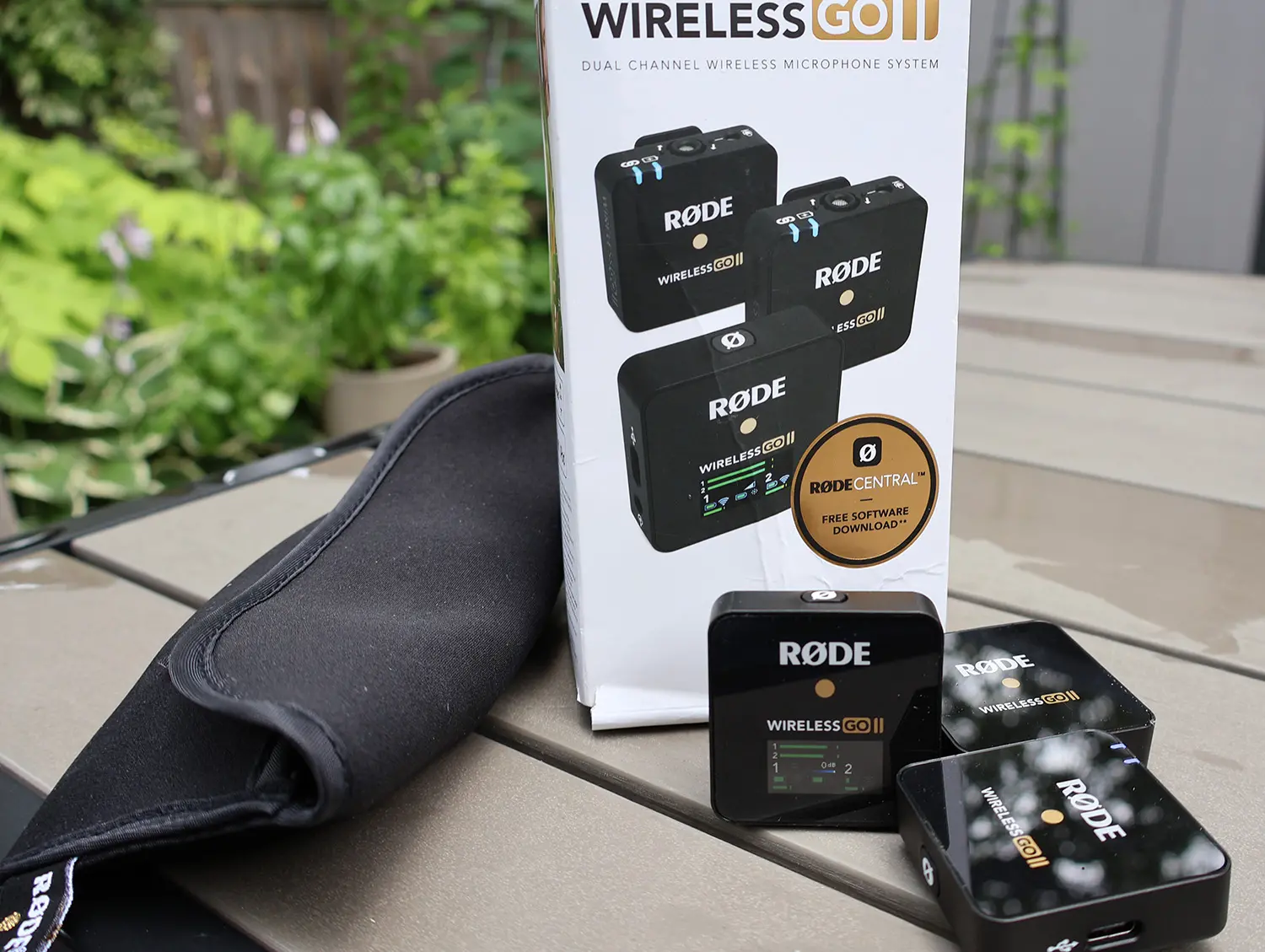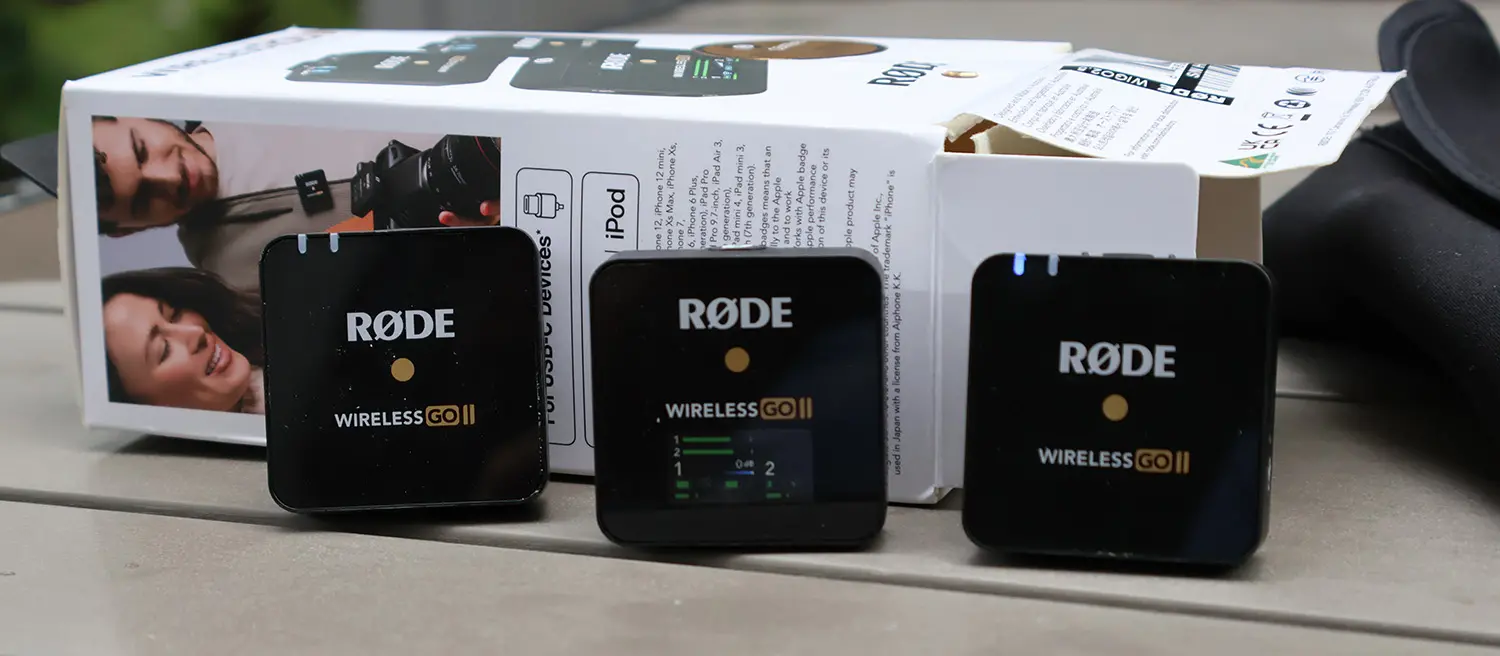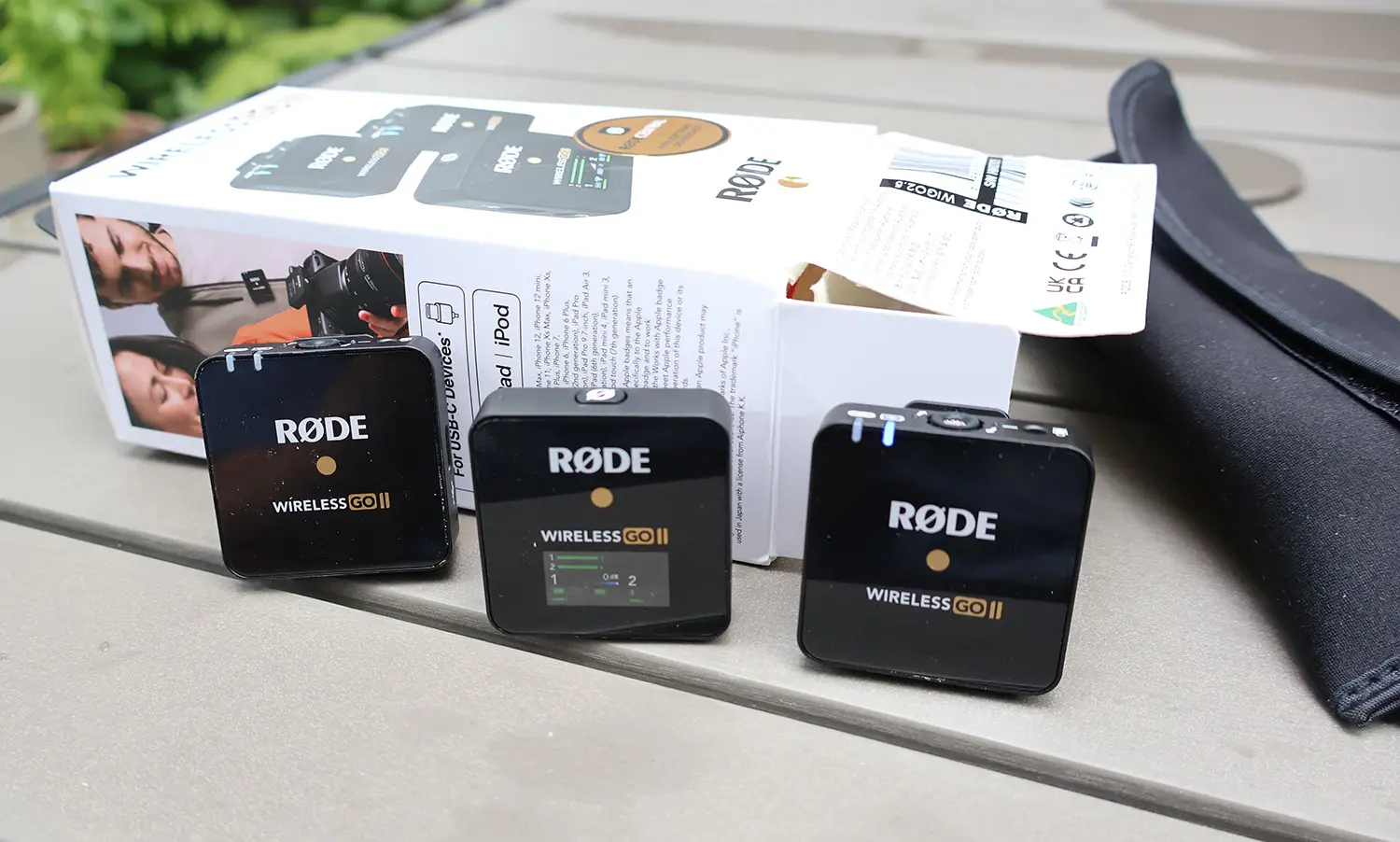
Australian company RØDE has been at the forefront of professional and prosumer audio equipment for many years, with their brand emblazoned on everyone from self-produced videographers to big budget Hollywood productions. Their reputation for rock-solid performance and pioneering engineering solutions is well regarded in the audio community, and they continue this tradition with the latest iteration of their wireless mic solution—the RØDE Wireless Go II dual mic system. Can it get the job done and done well?
RØDE Wireless Go II specs
- Weight: ~32g
- Battery life: Up to 7 hours
- Input: 3.5mm TRS (lavalier microphone)
- Output: 3.5mm TRS / USB-C audio
- Range: 200m
- USB-C charging
- Onboard recording: 24 hours (compressed) / 7 hours uncompressed per transmitter
- App: RØDE Central (iOS/Android/MacOS/Windows)

Unboxing the RØDE Wireless Go II microphone system
Inside a simple cardboard box you’ll find the two transmitters and receiver. When powered off they look almost identical, though of course the transmitters have a small mic on the side, while the receiver has the same 3.5mm jack for output to a camera. The receiver has its screen that’s barely visible when off, and in a dark environment it wouldn’t be super simple to tell these apart by touch alone. There are two small LEDs on the sides of the transmitter units, and at the back they have strong plastic clips. There are no magnetic elements to aid when clipping isn’t an option, unfortunately.
Included in the box are three short USB-C to USB-A cables. To charge all three with the included cables you’ll need a USB hub that has enough port or three separate USB-C cables with a similar charging solution. There’s no way to daisy chain them while charging, and no “hydra” cable is included to allow multiple devices to charge at once off a single port.
A utilitarian carry pouch is included, as well as a 3.5 TRS cable for plugging the receiver into a camera. Unfortunately there’s no TRRS cable included for devices that may require that input, though such cables are of course sold separately by RØDE and other manufactures.
The small devices are slightly slick to touch, with simple power on/off buttons. The RØDE Central app, available for iOS and Android, is required for some of the higher level functions, but for the most part you can take it out of the box and be ready to go.
Using the RØDE Wireless Go II dual mic system
Being the second iteration of this groundbreaking device, the RØDE Wireless Go II has improved both its transmission strength (up to 200m), and, through use of dual channel technology, you’re able to capture clear audio even in noisy, RF-congested areas. The audio is encrypted end-to-end, and with up to 24 hours of internal compressed recording you are able to use these even when not plugged into another device. You can set it up to ensure a backup recording on-device, an absolute boon for when there’s an issue between your receiver and the recording device, meaning at least one facet of self-production can be slightly less stressful.
There are meters that show the line levels between transmitter and receiver, but unfortunately the screen is mounted on the top of the unit. This means when set on a hot-shoe on your camera you’re unable to see these indicators, a factor that may be frustrating for some wishing to be able to see while facing the camera for vlogging and the like.
The built-in omnidirectional microphones do a good job at capturing voices even in slightly noisy environments, and you can set it to either record both transmitters summed into a stereo recording, or split so that you can have each transmitter be given a unique track to modify in post-production.
If you wish you may bypass the condenser capsule mic and plug in a lav, though the input requires a TRS connector, meaning that if you have a TRRS lav you’ll need an adapter. There are other accessories that work with the kit, from the Interview Go that turns one of the transmitters into a handheld mic, or a variety of other clips including magnetic options. Out of the box, however, you’re treated to only the standard clip which feels robust and managed to stay in place during even walk-and-talk testing.
While there is a charging case available for purchase separately, charging all three devices with the included cables at once is quite cumbersome and inelegant. Luckily, the battery life is quite good, but at the end of the day the nest of cables and wireless devices feels an inelegant solution for such a capable product.

Audio quality
Unsurprisingly, the recording quality of the devices was excellent, especially when using an external lav microphone. With a 50Hz – 20kHz range for the built-in mic, you get a clear signal that’s more than sufficient for most use cases, yet the directionality and ease of setup with a lav grants the flexibility of choosing the right mic for the right situation, with the same level of rock solid transmission regardless if you’re using an external or internal mic.
App support for the RØDE Wireless Go II
The software support for the RØDE Wireless Go II mic system is class leading, and you can easily unlock many advanced features via your PC or mobile device. You can use these devices as part of the entire RØDE ecosystem, with the RØDE Connect software brilliant for streamers or podcasters wanting multiple participants speaking with separate channels for each. You can even upgrade further to sync the transmitters with the company’s remarkable RØDEcaster mixer, adding each of these transmitters into a multi-channel studio system. The apps and desktop software are refined and easy to use, and it’s in these final touches that one can see just how robust and powerful the deceptively simple microphones can be.
Final thoughts
Credit where it’s due, the RØDE Wireless Go II continues a legacy set by the ground-breaking original version. There are still some frustrations, from the janky way you have to charge all three devices without an included case, the placement of the metering screen, and so on. Yet despite these quibbles, these are exceptionally capable devices that rival professional-level solutions, and if you’re already part of the RØDE ecosystem, they’re an absolute must have to add to your audio quiver. These are well-built, well-engineered products that more than live up to the storied name of the Australian company.
For those just starting out or veterans of audio recording, the RØDE Wireless Go II microphone system should definitely be on your list to consider.




